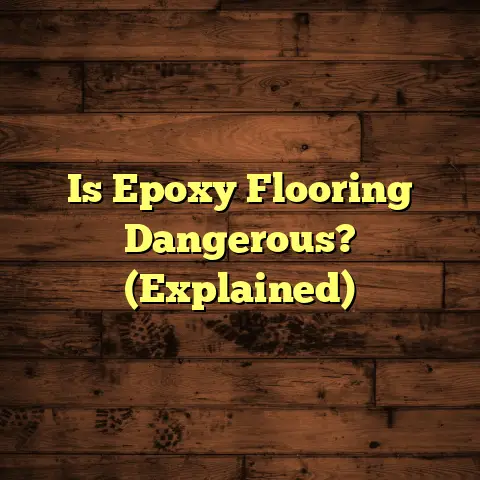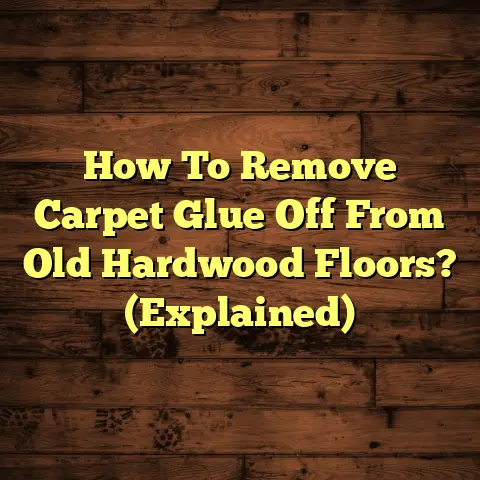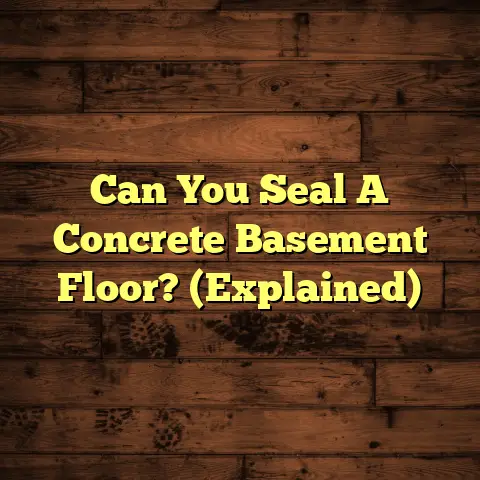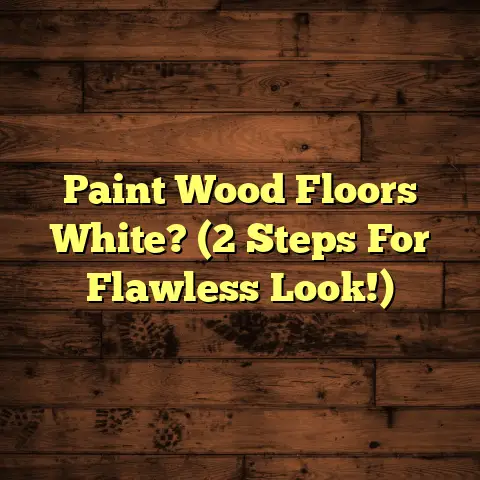How to Paint Your Garage Floor (5 Prep Steps!)
Think of painting like building a cake. You don’t just slap on frosting, right? You need layers: the cake itself, a crumb coat, and then the final, beautiful layer of frosting.
Painting your garage floor is the same. It’s all about layering. A well-executed paint job requires multiple layers, each serving a specific purpose.
The foundation for a successful paint job is laid long before you even crack open the can of paint. It’s all in the prep work.
I’ve seen countless garage floors fail because of rushed or skipped prep steps. Trust me, investing time upfront saves you headaches (and money!) down the road.
In this article, I’m going to walk you through the 5 essential prep steps that will set you up for a garage floor that looks great and stands the test of time. Let’s get started!
Section 1: Understanding Garage Floors
Before you even think about color swatches, let’s talk about the canvas you’re working with: your garage floor.
Most garage floors are made of concrete, but you might encounter epoxy-coated floors as well. The type of floor affects the painting process.
-
Concrete: Porous and needs proper cleaning and etching for paint to adhere.
-
Epoxy: Requires a different approach, usually involving sanding and a specialized primer.
Why bother painting your garage floor in the first place? Here are a few solid reasons:
-
Aesthetic Appeal: A clean, painted floor instantly brightens up your garage and makes it a more inviting space.
-
Protection: Paint acts as a barrier against oil spills, road salt, and other nasty stuff that can damage your concrete.
-
Easy Cleaning: Painted floors are much easier to clean than bare concrete. Just sweep or mop!
Now, let’s talk paint. You can’t just use any old paint on a garage floor. You need something tough and durable.
Here are some popular choices:
-
Epoxy Paint: Known for its durability and resistance to chemicals and abrasion. Often comes in two-part kits that you mix together.
-
Acrylic Latex Paint: A more affordable option, but not as durable as epoxy. Look for paints specifically formulated for concrete floors.
-
Polyurethane: Offers excellent abrasion resistance and a glossy finish. Often used as a topcoat over epoxy.
Choosing the right paint is crucial. Cheaping out here will only lead to disappointment and the need to redo the job sooner than you’d like.
I’ve personally used epoxy paint on my own garage floor and have been extremely happy with the results. It’s held up well to heavy use and spills.
Section 2: Prep Step 1 – Clear the Garage
Okay, let’s get practical. First things first: you need to empty your garage. I know, I know, it’s a pain. But trust me, it’s essential.
Trying to paint around a bunch of clutter is a recipe for disaster. You’ll end up with uneven coverage, missed spots, and a whole lot of frustration.
Here’s how to tackle the garage clearing process:
-
Take Inventory: Before you start hauling stuff out, take a quick inventory of everything in your garage. This will help you decide what to keep, donate, or toss.
-
Organize: Sort your belongings into categories: tools, sports equipment, holiday decorations, etc. This will make it easier to find a temporary home for everything.
-
Storage Solutions: If you have a shed or spare room, that’s great. If not, consider renting a storage unit or asking a friend if you can borrow some space.
-
Heavy Lifting: Moving heavy items can be dangerous. Enlist the help of friends or family, or rent a dolly or hand truck. Always lift with your legs, not your back!
-
Safety First: Wear gloves and eye protection when handling potentially dirty or dusty items. Be mindful of sharp objects and tripping hazards.
I remember one time, I tried to cut corners and paint around my workbench. Big mistake! I ended up with paint splatters all over my tools and a very unprofessional-looking floor. Learn from my mistakes!
Tip: As you remove items from your garage, take the opportunity to declutter. Get rid of anything you don’t need or use. A clean garage is a happy garage!
Section 3: Prep Step 2 – Assess and Repair the Floor
Now that your garage is empty, it’s time to take a close look at your floor. We’re looking for any damage that needs to be repaired before we start painting.
Cracks, chips, and spalling (flaking concrete) are common problems. These imperfections can affect the adhesion of the paint and lead to premature failure.
Here’s how to assess and repair your garage floor:
-
Inspect Thoroughly: Use a flashlight to carefully examine the entire floor surface. Pay close attention to corners, edges, and areas that get a lot of traffic.
-
Identify Damage: Mark any cracks, chips, or spalling with a marker or tape. This will help you keep track of the areas that need repair.
-
Clean the Damage: Use a wire brush or scraper to remove any loose debris from the damaged areas. This will ensure that the patching compound adheres properly.
-
Choose the Right Patching Compound: For small cracks and chips, use a concrete patching compound or epoxy filler. For larger areas of spalling, you may need to use a concrete resurfacer.
-
Apply the Patching Compound: Follow the manufacturer’s instructions for mixing and applying the patching compound. Use a trowel or putty knife to smooth it out and make it flush with the surrounding surface.
-
Allow to Cure: Let the patching compound cure completely before sanding or painting. This may take several hours or even days, depending on the product.
-
Sand Smooth: Once the patching compound is cured, sand it smooth with a sanding block or orbital sander. This will create a seamless surface for painting.
A smooth surface is essential for optimal paint adhesion. If you skip this step, the paint may peel or flake off over time.
I’ve found that using a self-leveling concrete resurfacer is a great way to fix large areas of spalling. It creates a smooth, even surface that’s perfect for painting.
Tip: For deep cracks, you may need to use a crack injection system. These systems use a special epoxy that is injected into the crack to seal it and prevent further damage.
Section 4: Prep Step 3 – Clean the Floor
Alright, we’ve cleared the garage and repaired any damage. Now it’s time to get down and dirty (literally) and clean that floor.
This is arguably the most important step in the entire process. If your floor isn’t clean, the paint won’t adhere properly, and all your hard work will be for nothing.
Here’s how to clean your garage floor like a pro:
-
Gather Your Supplies: You’ll need a stiff-bristled brush, a bucket, a hose, a degreaser, and a concrete cleaner.
-
Sweep the Floor: Start by sweeping the entire floor to remove any loose dirt, dust, and debris.
-
Apply Degreaser: Oil stains are a common problem in garages. Apply a degreaser to any oil stains and let it sit for the recommended amount of time.
-
Scrub the Floor: Use the stiff-bristled brush to scrub the entire floor with a concrete cleaner. Pay extra attention to areas with heavy dirt or grime.
-
Rinse Thoroughly: Rinse the floor thoroughly with a hose to remove all traces of the cleaner and degreaser.
-
Pressure Wash (Optional): For heavily soiled floors, consider using a pressure washer to deep clean the surface.
-
Dry Completely: Allow the floor to dry completely before moving on to the next step. This may take several hours or even overnight.
I always recommend using a concrete cleaner specifically designed for garage floors. These cleaners are formulated to remove tough stains and grease without damaging the concrete.
Tip: To test if your floor is clean enough, sprinkle some water on the surface. If the water beads up, the floor is still dirty and needs to be cleaned again. If the water spreads out evenly, you’re good to go!
I once painted a garage floor without properly cleaning it first. The paint started peeling within a few months, and I had to redo the entire job. Talk about a waste of time and money!
Section 5: Prep Step 4 – Etch or Prime the Surface
Okay, we’re almost there! We’ve cleared, repaired, and cleaned the floor. Now it’s time to prepare the surface for paint adhesion.
This is where etching and priming come in. These steps are crucial for ensuring that the paint bonds properly to the concrete and lasts for years to come.
-
Etching: Etching involves using a chemical solution to open up the pores of the concrete, creating a rough surface that the paint can grip onto.
-
Priming: Priming involves applying a coat of primer to the concrete, which helps to seal the surface, improve adhesion, and enhance the longevity of the paint.
Here’s how to etch and prime your garage floor:
-
Choose Your Method: You can either etch the floor with a chemical etcher or use a concrete grinder to mechanically abrade the surface. I recommend using a chemical etcher for most DIY projects.
-
Apply Chemical Etcher: Follow the manufacturer’s instructions for applying the chemical etcher. Typically, you’ll need to dilute the etcher with water and apply it to the floor with a sprayer or mop.
-
Scrub the Floor: Use a stiff-bristled brush to scrub the floor while the etcher is still wet. This will help to remove any remaining dirt or contaminants.
-
Rinse Thoroughly: Rinse the floor thoroughly with a hose to remove all traces of the etcher.
-
Allow to Dry: Allow the floor to dry completely before applying the primer.
-
Apply Primer: Choose a primer specifically designed for concrete floors. Apply the primer with a roller or brush, following the manufacturer’s instructions.
-
Allow to Dry: Allow the primer to dry completely before painting.
Safety is paramount when working with chemical etchers. Always wear gloves, eye protection, and a respirator. Work in a well-ventilated area.
Tip: To test if your floor has been properly etched, sprinkle some water on the surface. If the water soaks into the concrete, you’re good to go. If the water beads up, you need to etch the floor again.
I’ve found that using an epoxy primer is a great way to improve adhesion and create a durable base for the paint. It’s a bit more expensive than other primers, but it’s worth the investment.
Section 6: Prep Step 5 – Choose the Right Weather Conditions
Believe it or not, the weather can have a big impact on the success of your garage floor painting project.
Temperature and humidity can affect the drying time and adhesion of the paint. Painting in the wrong conditions can lead to a poor finish and premature failure.
Here’s what you need to consider when choosing the right weather conditions:
-
Temperature: Most garage floor paints require a minimum temperature of 50°F (10°C) to dry properly. Avoid painting in temperatures below this threshold.
-
Humidity: High humidity can slow down the drying time of the paint and prevent it from adhering properly. Aim for humidity levels below 80%.
-
Rain: Avoid painting on days when rain is expected. Rain can wash away the paint before it has a chance to dry.
-
Sunlight: Direct sunlight can cause the paint to dry too quickly, leading to cracking and peeling. Try to paint in the shade or on a cloudy day.
Before you start painting, check the weather forecast and plan your painting day accordingly. If the weather isn’t ideal, wait for a better day.
Tip: Use a hygrometer to measure the humidity level in your garage. This will help you determine if the conditions are right for painting.
I once tried to paint my garage floor on a day that was too humid. The paint took forever to dry, and it ended up with a sticky, uneven finish. I had to sand it down and start over.
Personal Story: I remember one time, I was helping a friend paint his garage floor. We had done all the prep work, and the weather was perfect. We started painting in the morning, and by the afternoon, the floor looked amazing. My friend was so happy with the results that he threw a garage party that night! It was a great feeling to know that I had helped him transform his garage into a space he could be proud of.
Conclusion
So, there you have it: the 5 essential prep steps for painting your garage floor. I know it seems like a lot of work, but trust me, it’s worth it.
By investing time and effort in preparation, you’ll be rewarded with a garage floor that looks great, lasts for years, and adds value to your home.
Remember, painting is all about layering. Each step builds upon the previous one, creating a strong and durable foundation for the final finish.
Don’t cut corners, follow these steps carefully, and you’ll be well on your way to a garage floor you can be proud of.
Now get out there and transform your garage! Good luck!





